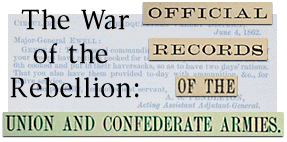Summary:
Union General William S. Rosecrans outlines plans for operations in the
Shenandoah Valley, including Staunton and Augusta County, in March, 1862.
HDQRS. DEPARTMENT OF WESTERN VIRGINIA,
Brig. Gen. L. THOMAS,
Adjutant-Gen. U. S. Army,
Washington, D. C.:
Wheeling
March 12, 1862.
GEN.:
Since the valley of Virginia, except the valleys of Great and Little Cacapon and of the Shenandoah, had been added to the limits of this department, I beg leave to submit for the consideration of the Secretary of War a project of operations deemed feasible within the limits of this department:
1. The exclusion of Rockbridge and Augusta Counties, containing Lexington and Staunton, leaves nothing to be done on our eastern limits but to expel the eight rebel forces of, say, 3,500 men, from the valley, to occupy the passes on main roads, hold the important points with forces sufficient to guard them, and tranquilize the country. This should be done by a force moving from Cumberland, New Creek, &c., up the valley of the South Branch of the Potomac, via Franklin and Dunwiddie's Gap, to capture if possible the rebel forces at Fort Alleghany, on the Beverly and Staunton turnpike. The main force at Huttonsville should co-operate with this, leaving a sufficient guard against a flank movement by Gen. Heth, who commands at Lewisburg and Huntersville.
The force required for this operation from Cumberland should be four regiments of infantry, one of cavalry, and a good battery of artillery, of which three regiments of infantry and the one of cavalry are still required. The conduct of this column should be such, if possible, as to cut off the retreat of the rebel troops on Staunton, and when the Beverly road is in our hands the troops on Cheat Pass should unite with this column, seize the railroad at Millborough, and act as occasion may require towards the rebel forces in the direction of Staunton and Lexington, while we in sufficient force seize Warm Springs and Jackson River Depot, cutting off the retreat eastward of any rebel troops that may be in Greenbier.
The general commanding should be charged with the restoration of law, order, and confidence in the Government of the United States, and should the rebels hold their ground east of the Blue Ridge, to guard the great passes from East to West Virginia against unexpected projects or reverses of our arms.
Second objective, by a simultaneous movements, begun with the least practicable delay, should be from Gauley Brigade to seize Lewisburg, White Sulphur, and to strike the Southwestern Virginia and Tennessee Railroad at some point between Bonsack's and Salem, the nearer Bonsack's the better. This column should consist of a force sufficient to expel Heth, hold Greenbier, protect the depots there, and hold the railroad with 2,000 men, a field battery, and a couple of squadrons of cavalry. They should establish and garrison depots at Lewisburg and Union.
A third objective would be holding Fayette, to establish a depot at Raleigh, and from thence seize the railroad at Wytheville or Newbern, hold it in force against the rebels, and pacify the country there immediately.
Fourth object. The force now on Big Sandy can be supplied with provisions by small steamboat navigation in time of high water to Pikeville, whence it is 88 miles over bad roads to Baker's Station, on the Southwestern Virginia and Tennessee Railroad. This column should move by the Louisa Ford to Buchanan and Jeffersonville, seize the Northwest Virginia Branch Bank there, and thence take possession of the railroad at the Salt Works. Should the rebels be at Pound Gap a demonstration of a movement should be made and watched to keep the attention of them, while the main column, pursuing the route indicated, would seize the railroad and cut off the retreat of these rebel forces.
These forces once in the valley, Wytheville, Abingdon, Newbern, &c., all succumb. Troops purchase what they need for subsistence.
The estimated force requisite for all these purposes, based on the assumption that rebel capacity for local mischief in these regions should what we now have, would be:
For the Cumberland column-Three regiments of infantry, one regiment of cavalry, and one battery of artillery.
For Cheat Pass--One regiment of infantry.
For Kanawha--One regiment of infantry and one battery of artillery.
For Big Sandy--One regiment of infantry.
Total--Six regiments of infantry, one regiment of cavalry, and two field batteries, the most important of which are the three regiments of infantry and one of cavalry at Cumberland. They should be sent there without delay. Should they be ordered from an adjoining State, time could be gained by sending forward all troops on the railroad except those strictly requisite to guard the railroad line and the depots. Should the rebel forces east of the Blue Ridge fall back towards Lynchburg, retaining their organization and force, as now seems possible, I would advise strengthening the Lewisburg column so as to make and effective force of from 12,000 to 15,000 men, with orders to seize the Southwestern Virginia and Tennessee Railroad, and make a strong demonstration on Lynchburg, seizing it if opportunity offers. On this supposition an additional force of 6,000 or 8,00 men should be thrown into the great valley, to occupy August and Rockbridge and watch the passes through the Blue Ridge there and southward.
Very respectfully, your obedient servant,
W. S. ROSECRANS,
Brig.-Gen., U. S. Army.
Bibliographic Information : Letter Reproduced from The War of The Rebellion: Official Records of the Union and Confederate Armies, Series 1, Volume 5, Serial No. 5, Pages 744-746, Broadfoot Publishing Company, Wilmington, NC, 1997.

